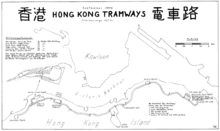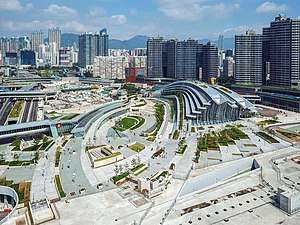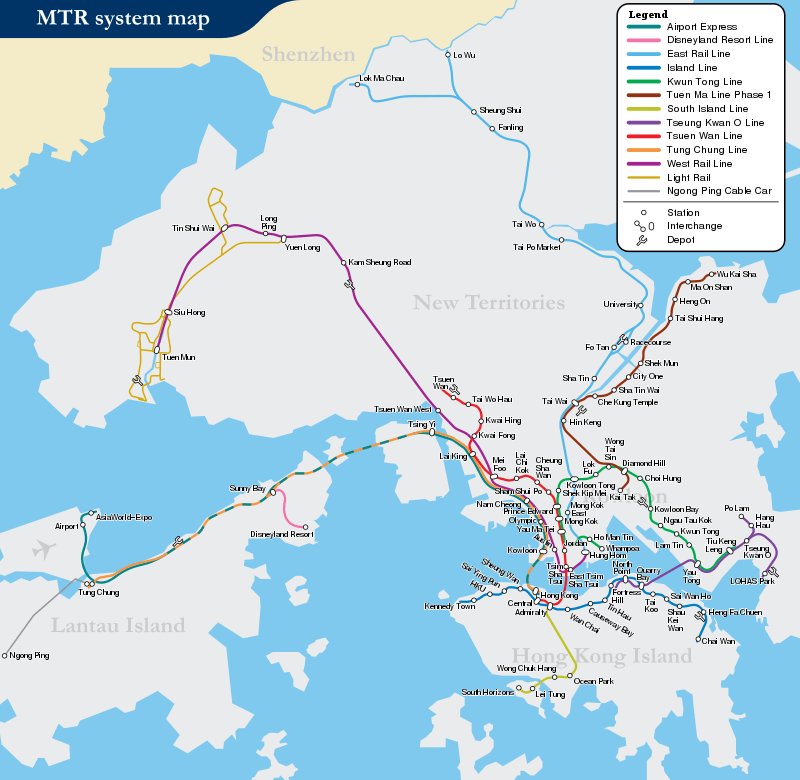Rail transport in Hong Kong
Hong Kong's rail network mainly comprises public transport trains operated by the MTR Corporation Limited (MTRC). The MTRC operates the metro network of Hong Kong and the commuter rail network connecting the northeastern and northwestern New Territories to the urban area. The operations of the territory's two leading railway companies, MTRC and the Kowloon-Canton Railway Corporation (KCRC), were merged in 2007 on grounds of economies of scale and cost effectiveness. The Hong Kong Government has an explicit stated transport policy of using the railway as its transport backbone.[1]
In addition to the MTR network, there are several smaller railways run by different operators, including the Peak Tram and the Hong Kong Tramways.
History
The first mode of rail transport in Hong Kong was the Peak Tram, serving The Peak, the Mid-levels and the city centre since 1888. Tram started service along the northern coast of the Hong Kong Island in 1904. The British Section of the Kowloon-Canton Railway (later the KCR East Rail), a conventional railway, was opened in 1910.
It was not until 1979 that a rapid transit system, the MTR, was opened. Three years later, the British Section of the Kowloon-Canton Railway began its transition towards electrification, changing it into a commuter rail, and eventually providing rapid transit-like service. The Light Rail Transit (LRT, now the MTR Light Rail) began its operation in the Tuen Mun and Yuen Long new towns in 1988. The two railway companies, MTR Corporation Limited and Kowloon-Canton Railway Corporation, merged in 2007 to form a single rapid transit network.
In 2018, the Guangzhou-Shenzhen-Hong Kong High Speed Railway opened to connect Hong Kong with the Mainland Chinese high speed network through a 26 km tunnel within Hong Kong to West Kowloon Station. It has many train services to many Mainland Chinese cities such as Beijing, Guangzhou and Shenzhen.
There are several extensions planned or under construction, such as the Sha Tin to Central Link.
MTR
The MTR network comprises 10 lines, 95 railway stations and 68 Light Rail stops:
- East Rail line: between Lo Wu/Lok Ma Chau and Hung Hom (formerly part of KCR/KCRC)
- Kwun Tong line: between Whampoa and Tiu Keng Leng
- Tsuen Wan line: between Tsuen Wan and Central
- Island line: between Kennedy Town and Chai Wan
- South Island line: between Admiralty and South Horizons
- Tung Chung line: between Tung Chung and Hong Kong
- Tseung Kwan O line: between Po Lam/LOHAS Park and North Point
- Disneyland Resort line: between Sunny Bay and Disneyland Resort
- West Rail line: between Tuen Mun to Hung Hom (formerly part of KCR/KCRC)
- Tuen Ma line: between Wu Kai Sha to Kai Tak (formerly part of KCR/KCRC for Wu Kai Sha to Tai Wai section)
- Airport Express: between AsiaWorld-Expo/Airport and Hong Kong
- Light Rail: 68 stations serving the northwest New Territories (formerly part of KCR/KCRC)
This system makes about $2 billion in profit in 2014 which is mainly generated from its property holding and development business.[2] Its portfolio include two of the city's tallest skyscrapers.[2]
Trams

- Hong Kong Tramways: Double-decker trams, running on the north shore of Hong Kong Island from Kennedy Town to Shau Kei Wan.
- Peak Tram: A funicular railway with six stations, connecting Central and the Victoria Peak.
- Po Fook Hill Elevator: A funicular railway with two stations, connecting the car park and the upper section of Po Fook Hill Cemetery.
- Discovery Bay Elevator: A funicular railway with two stations, connecting Discovery Bay North Plaza and Amalfi.
Note that the MTRC Light Rail system (see above) has many of the attributes of a tramway, including street running.
Cross-border services
High speed rail
.jpg)

A high-speed rail link connects Hong Kong with Shenzhen and Guangzhou in mainland China. The Hong Kong section of the Guangzhou–Shenzhen–Hong Kong Express Rail Link (sometimes abbreviated "XRL HK section") is a 26-km long stretch of high-speed rail that links Hong Kong to mainland China. The Hong Kong section opened for commercial service on 23 September 2018.[3] From West Kowloon Terminus, trains run through regional stations in Guandong Province, including Futian, Longhua (Shenzhen North), and Humen, to Guangzhou South Station and other cities in other provinces.[4][5]
With the completion of the rail link, the journey times have been reduced to 14 minutes between West Kowloon and Futian stations, 23 minutes between Hong Kong and Shenzhen North and 48 minutes between Hong Kong and Guangzhou South.[6] The service is a cooperation between the MTR Corporation and CR Guangzhou.
West Kowloon Station is served by both short-distance and long-haul train services. Short-distance services consist of a frequent service to mainland Chinese cities in neighbouring Guangdong province, including Shenzhen, Dongguan and Guangzhou, while long-distance services link Hong Kong to at least 16 major destinations in mainland China, including Beijing West, Shijiazhuang, Zhengzhou East, Wuhan, Changsha South and Shanghai Hongqiao.[7]
A new railway connecting Guangzhou, Shenzhen and Hong Kong was proposed in the late 1990s by the Government of Hong Kong. This Regional Express Railway (RER) proposal was developed in the 1994 “Railway Development Study” (RDS); it foresaw a continual growth of Hong Kong's population over the next two decades and strong demand for cross-border passenger traffic.[8] By 2002, the concept of “regional express” gained further development and the proposal was advanced to be a high-speed rail line.[9] Construction of the Hong Kong section began in 2010. Following delays and controversies,[10][11][12] West Kowloon station was formally opened on 4 September 2018 and high speed trains started to run on the rail link to destinations in Mainland China from 23 September 2018.[13]
English |
Chinese |
Distance |
|||
| Hong Kong West Kowloon | 香港西九龍 / 香港西九龙 | Yau Tsim Mong, Hong Kong | |||
Guangdong through train
Commonly known as through train (chi. 直通車), the MTRC and railway companies of mainland China jointly provide cross-border train services from Hung Hom station, Kowloon, sharing most of the tracks with the East Rail line, to destinations in mainland China through neighbouring Shenzhen on three Through Train routes, namely Beijing line (to/from Beijing), Shanghai line (to/from Shanghai) and Guangdong line (to/from Zhaoqing and Guangzhou East). The Through Train is a legacy of Hong Kong's first railway, the Kowloon-Canton Railway. It is operated through the rail network in mainland China, including the Guangshen railway and Jingguang railway.
Automated People Mover
There is an Automated People Mover (APM),[14] a driverless electric train service, which is located at the basement level of Terminal 1 of Hong Kong International Airport. It travels the length of the 750-metre concourse between the East Hall and West Hall on a circular mode. Running at a speed of 62 km per hour, each APM carries 304 passengers in four cars. The APM operates every 2.5 minutes from 0600 to 0030 hours every day. It transports passengers whose flights are located at the West Hall, Southwest and Northwest concourses.
Rail gauges and power supply
Rail gauges and power supply of Hong Kong rails.
| Rail | Rail gauge | Power supply | Remarks | Signal system | Height of platform | Width of widest car (mm) | Loading gauge width (mm) | Height of tallest car (mm) | Height clearance | Height of contact wire
(mm) | |
|---|---|---|---|---|---|---|---|---|---|---|---|
| MTR Island line, South Island line, Kwun Tong line, Tseung Kwan O line, Tsuen Wan line (collectively Urban Lines except for South Island Line)[15] | 1,432 mm (4 ft 8 3⁄8 in) (except for West Island Line, South Island Line, and Kwun Tong Line Extension) (almost standard gauge) 1435 mm (West Island Line, South Island Line, and Kwun Tong Line Extension) |
1500 V DC | overhead cable | SACEM and SACEM-SICAS for TKL, all lines to be upgraded to SelTrac in the 2020s | 1100 mm (43.3 in) | 3118 | 3250 (with fixed platform gap filler) 3312 (without gap filler)
3940 (without platform)[16] |
3700 (MTR Metro Cammell EMU (DC) without pantograph)
3910 (MTR Metro Cammell EMU (DC) with pantograph folded) |
3755 mm (without pantograph)[16]
4100 mm (with pantograph folded) (~4904 mm with pantograph folded in depots) |
4200 mm (nominal and min., as built to same standards as Tung Chung Line and Airport Express);
(~5029 mm in depots) | |
| MTR Tung Chung line, Airport Express (collectively known as Airport Railway) | 1,432 mm (4 ft 8 3⁄8 in)
(almost standard gauge) |
1500 V DC (nominal) ; 1520 ± 20 V DC (in practice)[17] | overhead cable | SACEM, all lines to be upgraded to SelTrac in the 2020s | 1250 mm (49.2 in)[16] | 3118 (MTR Rotem EMU) | 3250 (with fixed platform gap filler) 3312 (without gap filler)
3940 (without platform)[16] |
3700 (MTR Adtranz–CAF EMU without pantograph) | 3755 mm (without pantograph)[16]
4100 mm (with pantograph folded) (~4904 mm with pantograph folded in depots) |
4200 mm (nominal and min.);
4224.78 mm (mean); 4230 mm (max. on running lines)[17](~5029 mm in depot) | |
| MTR Disneyland Resort line | 1,432 mm (4 ft 8 3⁄8 in)
(almost standard gauge) |
1500 V DC | overhead cable | SelTrac CBTC/R UTO | 1100 mm (43.3 in) | 3096 | 3250 (with fixed platform gap filler) 3312 (without gap filler)
3940 (without platform)[16] |
3700 (without pantograph)
3910 (with pantograph folded) |
3755 mm (without pantograph)[16]
4100 mm (with pantograph folded) (~4904 mm with pantograph folded in depots) |
4200 mm (nominal and min., as built to same standards as Tung Chung Line and Airport Express);
(~5029 mm in depot) (note: depot shared with Airport Railway) | |
| MTR East Rail line, West Rail line, Tuen Ma line (formerly operated by KCR/KCRC) | 1,435 mm (4 ft 8 1⁄2 in) (Standard gauge) | 25 kV AC | overhead cable | electrical supply same standard as railways in mainland China | East Rail line GEC-Alsthom TBL,Will be Resignal by Siemens Trainguard MT CBTC West Rail line, Tuen Ma line SelTrac CBTC DTO | 3 ft 6 in (1066.8mm)[18] | 3220 (MTR Hyundai Rotem EMU) | 3250 (with fixed platform gap filler) 3300 (without gap filler)
~3900 (without platform) |
4600
(Ktt Kinki Sharyo coach)[19] |
16 ft 6 in (5029.2 mm) (with pantograph folded) | 17 ft 4 in (5283.2 mm)[18] (nominal and minimum) |
| MTR Light Rail (formerly operated by KCR/KCRC) | 1,435 mm (4 ft 8 1⁄2 in) (Standard gauge) | 750 V DC | overhead cable | Siemens Trainguard IMU 100 | 910 mm
(35.8 in) |
2650 | 2670 | 5250 mm (with pantograph folded) | 5300 mm (nominal and minimum) | ||
| Guangzhou-Shenzhen-Hong Kong Express Rail Link Hong Kong section | 1,435 mm (4 ft 8 1⁄2 in) (Standard gauge) |
25 kV AC | overhead cable | everything same standard as railways in mainland China | 1250 mm (49.2 in) | 3380 | 3400 | 5250 mm (with pantograph folded) | 5300 mm[20] (nominal and minimum) | ||
| Peak Tram | 1,520 mm (4 ft 11 27⁄32 in) (Russian gauge) | N/A | N/A | Funicular | |||||||
| Hong Kong Tramways | 3 ft 6 in (1,067 mm) | 550 V DC | overhead cable | N/A | 20 ft 8 in (6299.2 mm) (with trolley pole folded) (estimated) | 21 ft (6400.8 mm) (estimated) | |||||
| Hong Kong International Airport Automated People Mover | N/A (Automated guideway transit) | 3-phase 600 V AC | Third Rail | SelTrac | |||||||
| Hong Kong Disneyland Railroad | 3 ft (914 mm) | N/A | N/A | powered by three steam-shaped diesel locomotives | |||||||
| Ocean Park Ocean Express | 1,435 mm (4 ft 8 1⁄2 in) (Standard gauge) | N/A | N/A | Funicular | |||||||
List of densely populated places without rail transport
- Hong Kong Island
- Aberdeen
- Wah Fu
- Kowloon
- Most of Tai Wo Ping (Shek Kip Mei)
- Tsz Wan Shan
- Sau Mau Ping and Shun Lee
- Most of To Kwa Wan, Ma Tau Wai, Kowloon City and San Po Kong
- New Territories
- Chai Wan Kok
- Sheung Kwai Chung
- Sai Kung
- Parts of Tsing Yi
MTR route map

Former systems
- Mount Parker Cable Car
- Kai Tak Amusement Park Monorail
- Lai Chi Kok Amusement Park Monorail
See also
- List of railways in China
- Rail transport in the People's Republic of China
- Transport in Hong Kong
References
| Wikimedia Commons has media related to Rail transport in Hong Kong. |
- http://www.thb.gov.hk/eng/psp/publications/transport/publications/rds2014.pdf
- Sigalos, MacKenzie. "How Hong Kong's subway turns a $2 billion annual profit". CNN Money. CNN. Retrieved 27 October 2016.
- "XRL to start operation on September 23". The Standard. 23 August 2018.
- "Transport and Housing Bureau - Policy / Issues in Focus". www.thb.gov.hk.
- "HONG KONG SECTION OF GUANGZHOU-SHENZHEN-HONG KONG EXPRESS RAIL LINK PROJECT PROFILE" (PDF).
- "Key Information". Express Rail Link. MTR Corporation. Retrieved 11 August 2015.
- "Frequency and Capacity". MTR Corporation. Retrieved 13 November 2010.
- "立法会参考资料摘要:铁路发展策略" (PDF). Legislative Council of Hong Kong. 16 May 2000. Retrieved 6 March 2011.
- "广深港间拟建区域快线 可能采用磁悬浮列车". 新华网. 1 February 2002. Retrieved 6 March 2011.
- "High speed rail link project delayed". RTHK. 16 April 2014.
- "Severely damaged TBM to delay Hong Kong XRL". Tunnellingjournal.com. 16 April 2014.
- Benjamin Haas (in Seoul) (4 September 2018). "Hong Kong cedes part of rail station to China in secretive ceremony". The Guardian. Retrieved 4 September 2018.
- "Mainland port area of cross-border express rail link terminus opens". Xinhua Net. 4 September 2018. Retrieved 4 September 2018.
- Hong Kong Airport
- MTR Urban Lines Vision Train
- "Redevelopment of Kowloon Station". HKU Scholars Hub.
- Shing, Adrian (12 September 2012). "Predicting the Contact Wire Wear of a Railway System Using ANN". Rail Knowledge Bank. Retrieved 28 February 2018.
- "Under the Wires to Lo Wu". The Railway Magazine. Retrieved 28 February 2018.
- "MTR Corporation Hong Kong, China Passenger Car". Kinki Sharyo. Retrieved 1 March 2018.
- Cheng, William (15 June 2014). "A Design Overview of Traction Power Supply System for the First High-speed Rail System in Hong Kong" (PDF). Electrical and Mechanical Services Department. Retrieved 28 February 2018.